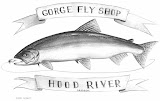I can say with 100% confidence that most every fly angler you know, started out by getting a 9 foot 5 weight single hand fly rod and uses it more than any other rod they have. For good reason too - this is going to be the most versatile, all purpose trout rod that can handle any technique you could need when your main target species is trout and other small warm water fish. Big nymph rigs, delicate dry fly rigs, small streamer setups, a single hand 5 weight has got you covered. However, after years of fishing a single hand rod, it can get monotonous and can cause shoulder pain and soreness after an entire day over hand casting trout flies.
Trout spey fishing has picked up in popularity in the west as an alternate and rewarding method when fishing for trout versus a traditional single hand fly rod. These rods are essentially mini spey rods that are designed to be extremely light as if you were fishing an actual single hand rod. A 12 inch Deschutes rainbow feels like you’re fighting a chrome bright steelhead on trout spey gear and is an absolute blast. Utilizing a two handed rod and making a variety of spey casts just as you would for steelhead, is an exciting and effective technique to use for trout, and our home water of the lower Deschutes, is tailor made for this application.
 |
| #4 olive sculpzilla did the trick on this healthy redside! |
My general Deschutes River setup:
My go to stick would be a 10’ 6”-11’ 3 or 4 weight trout spey rod, depending on the size of flies I’m fishing, general size of fish and river, wind conditions or just personal preference. There are lots of different trout spey models out there to choose from made by some of our favorite rod makers - Sage, Winston, C.F Burkheimer, Echo and Redington all have trout spey rods on the market. I recently had an epic day on the lower “D” (Deschutes River) swinging streamers to hungry trout using an Echo TS - 4110 (11’ 4 wt) weight rod. Click here to shop Echo Trout Spey rods I was running OPST lazor line in 35 pounds as my running line: Click here to shop running lines And a 330 grain Airflo Skagit Scout head to help turnover my sink tip and large fly. Click here to shop Airflo shooting heads
Connected to the shooting head, I was running a 10 foot section of straight T-8 sink tip which is my most used tip for much of the Deschutes and any larger river that is characterized by deep runs and heavy current. This has been a good setup for me when I am fishing small to mid size trout streamers with heavy Coneheads or dumbbell eyes.
Using this Skagit setup with a 4 weight rod allows me to throw larger streamers like a #4 Sculpzilla which is the fly I was having great success on:
Click here to shop for trout spey streamers
 |
| Here is a selection of effective trout spey streamers to use. |
I was also using a Sculpin pattern I tie called “the dirt” and fish were eating that too. Any small to mid size Sculpin imitation in olive, black or grey will get trout’s attention in the Deschutes. If you plan to fish smaller flies and soft hackle patterns more with Scandi type heads more frequently, then looking at a 1 or 2 weight micro spey would be more suitable for that.
In terms of the presentation and type of water that yielded the most success out on the Deschutes, I was fishing the deep, and relatively fast moving runs. The trout definitely seemed to be staged in their typical summer holding water - the fast, heavily oxygenated riffles and chop water and even hooked a few that were nosed up in some white water. Think water that is moving about as fast as a brisk walking pace. During the warmer months of the year when the water temps are up a bit, trout are much more willing to chase a streamer and move out of their holding spot further to eat a fly. Much of my eats were broadside where I’d make a cast more perpendicular to the current, throw a slight mend to let the fly sink, then let the fly swing fast coming across the current. Utilizing this presentation over a slower swing allows the fish to see the whole profile of the fly versus just the back end of it and usually causes a more aggressive chase down eat. In the colder months of spring and fall, fish are going to be less likely to move out of their “zone” to eat a swung fly, so focus on slowing your swing down and having your fly swing more parallel to the current of the river. If you aren’t feeling any grabs, try giving your rod tip some aggressive pops or jigs to give that streamer a little life as it swims across the current.
 |
| Some serious shoulders on this lower Deschutes River beauty |
Trout spey is a unique and fun new method to use when targeting trout that I highly recommend if you’re looking to try something new. The casts you make are the same to that of steelhead spey casts and is a great way to get into two handed fly fishing. The grab from a trout feels the exact same as a steelhead or salmon and happens much more often throughout the day to keep you entertained. Give us a shout at the shop if you want to learn more about it and get outfitted!
Tight lines,
Zach












.jpg)











No comments :
Post a Comment